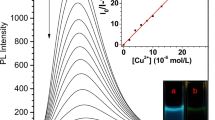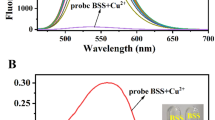Abstract
A novel coumarinylhydrazone fluorescent probe L was designed and synthesized from 4-(diethylamino)salicylaldehyde, its structure was characterized by NMR, IR. Fluorescence emission spectra showed that in ethanol solution, probe L could form a 1:1 complex L-Cu2+ with Cu2+ to realize the "turn-off" detection of Cu2+ with high specificity and sensitivity (3.7 × 10–7 mol/L). Meanwhile, the complex L-Cu2+ had a specific fluorescence-enhanced response to HPO42− with a detection limits down to 5.6 × 10–7 mol/L and was resistant to the effects of many common anions (NO2−, N3−, CO32−, SO32−, HPO42−, I−, Br−, F−, HCO3−, SO42−, NO3−, Cl−, CH3COO−, Cr2O72−, S2O32−, P2O74−). Detection mechanism could be HPO42− captured Cu2+ of the complex and released the free ligand L. At last, the complex L-Cu2+ was successfully applied to the determination of HPO42− in different environmental water samples, and the spiked recoveries ranged from 98.05% to 108.18% and the relative standard deviations of 0.75% ~ 2.9%, which had good application prospects.
Graphical Abstract
A new coumarin acyl hydrazone fluorescent probe L was designed and synthesized, which could specifically recognize Cu2+ and HPO42- in a relay manner. In addition, the probe had good prospects for practical applications.











Similar content being viewed by others
Availability of Data and Materials
No datasets were generated or analysed during the current study.
References
Graedel TE, Nassau K, Franey JP (1987) Copper patinas formed in the atmosphere-I. Introduction Corros Sci 27(7):639–657
Sauve S, Mcbride MB, Norvell WA et al (1997) Copper solubility and speciation of in situ contaminated soils: effects of copper level, pH and organic matter. Water Air Soil Pollut 100:133–149
Li B, Liu SP (2008) The technologies for treating waste water containing copper and research progress. Multipurp Utilization Mineral Resour 5:33–36
Meng YY, Wei F, Qi HP (2015) Review of determination for trace copper ion. Guangzhou Chem Ind 43(12):15–16
Donnelly PS, Xiao Z, Wedd AG (2007) Copper and Alzheimer’s disease. Curr Opin Chem Biol 11(2):128–133
Bisaglia M, Bubacco L (2020) Copper ions and Parkinson’s disease: why is homeostasis so relevant? Biomolecules 10(2):195
Barnham KJ, Bush AI (2008) Metals in Alzheimer’s and Parkinson’s diseases. Curr Opin Chem Biol 12(2):222–228
Antonucci L, Porcu C, Iannucci G et al (2017) Non-alcoholic fatty liver disease and nutritional implications: special focus on copper. Nutrients 9(10):1137
Patterson KY, Holbrook JT, Bodner JE et al (1984) Zinc, copper, and manganese intake and balance for adults consuming self-selected diets. Am J Clin Nutr 40(6):1397–1403
Babaali E, Rahmdel S, Berizi E et al (2020) Dietary intakes of zinc, copper, magnesium, calcium, phosphorus, and sodium by the general adult population aged 20–50 years in Shiraz, Iran: a total diet study approach. Nutrients 12(11):3370
Martin JF, Liras P (2021) Molecular mechanisms of phosphate sensing, transport and signalling in streptomyces and related actinobacteria. Int J Mol Sci 22(3):1129
Pollak N, Dolle C, Ziegler M (2007) The power to reduce: pyridine nucleotides–small molecules with a multitude of functions. Biochem J 402(2):205–218
Buck CL, Wallman KE, Dawson B et al (2013) Sodium phosphate as an ergogenic aid. Sports Med 43:425–435
Fuster JMB, Cortes PS, Bestard JP et al (2017) Plant phosphates, phytate and pathological calcifications in chronic kidney disease. Nefrología (English Edition) 37(1):20–28
Michigami T, Kawai M, Yamazaki M et al (2018) Phosphate as a signaling molecule and its sensing mechanism. Physiol Rev 98(4):2317–2348
Khan MN, Mohammad F (2014) Eutrophication: Challenges and solutions. Eutrophication: Causes. Consequences and Control 2:1–15
Ye RH, Chen Y, Liu YL et al (2011) Analysis of phosphorus-containing compounds in detergents by 31P nuclear magnetic resonance. J Instrumental Anal 30(6):624–628
Wysocki LM, Lavis LD (2011) Advances in the chemistry of small molecule fluorescent probes. Curr Opin Chem Biol 15(6):752–759
Nan XJ, Huyuan YC, Li HJ et al (2021) Reaction-based fluorescent probes for Hg2+, Cu2+ and Fe3+/Fe2+. Coord Chem Rev 426:213580
Wang LY, Tian Y, Liu SF et al (2017) A fluorescence-enhanced probe for PO43 based on a benzimidazole derivative. Fine Chemicals 34(7):740–759
Chowdhury S, Rooj B, Dutta A et al (2018) Review on recent advances in metal ions sensing using different fluorescent probes. J Fluoresc 28:999–1021
Wu XM, Wang H, Yang SX et al (2020) A fluorescent probe for the detection of Cu2+ and its application. Fine Chemicals 37(9):1769–1774
Sun L, Chen LL, Yang ZH et al (2023) A novel ratiometric dehydroabietic acid-based fluorescent probe for detecting HPO42 and its application in food samples. J Food Compos Anal 120:105316
Hashemi SM, Moradi SE, Ahangar RM et al (2023) Synthesis, sensing performance and DFT studies of a novel Coumarin-based Schiff base as a turn-on fluorescence probe for zinc ion detection. J Fluoresc 1–9
Du JH, Kan W, Zhao B et al (2022) An aggregate characteristic of relay fluorescence probe for Cu2+/HPO42– with improved low detection limit based on aggregation-switching mechanism. Inorg Chim Acta 538:120961
Sun XY, Liu T, Sun J et al (2020) Synthesis and application of coumarin fluorescence probes. RSC Adv 10(18):10826–10847
Fan YF, Wu Y, Hou J et al (2023) Coumarin-based near-infrared fluorogenic probes: recent advances, challenges and future perspectives. Coord Chem Rev 480:215020
Zhang D, Zang ZP, Zhou XY et al (2009) A selective fluorescence probe for yttrium (III) based on acylhydrazone Schiff base. Inorg Chem Commun 12(11):1154–1156
Pan X, Jiang JM, Li JF et al (2019) Theoretical design of near-infrared Al3+ fluorescent probes based on salicylaldehyde acylhydrazone schiff base derivatives. Inorg Chem 58(19):12618–12627
Acknowledgements
The authors are grateful to National Natural Science Foundation of China (No. 21908034) and Natural Science Foundation of Heilongjiang Province (No. LH2021H001).
Funding
This work was supported by National Natural Science Foundation of China (No. 21908034) and Natural Science Foundation of Heilongjiang Province (No. LH2021H001).
Author information
Authors and Affiliations
Contributions
Shukui Pang: Conceptualization, Methodology, Investigation, Visualization, Formal analysis, Writing – original draft. Yanchao Yu & Mianyuan Wu: Conceptualization, Methodology, Resources, Writing – review & editing, Supervision. Xuexue Yan & Canyao Wu: Software, Investigation, Formal analysis. Qiye Liu & Panru Zu: Software, Investigation, Formal analysis.
Corresponding authors
Ethics declarations
Ethics Approval
This is an observational study. The Harbin University of Science and Technology has confirmed that no ethical approval is required.
Consent to Participate
This declaration is "not applicable".
Competing Interests
The authors declare no competing interests.
Additional information
Publisher's Note
Springer Nature remains neutral with regard to jurisdictional claims in published maps and institutional affiliations.
Highlights
• Probe L could complete sequential recognition of Cu2+ and HPO42-.
• Probe L had the advantages of excellent specificity, high sensitivity, high immunity to interference and visualization.
• Probe L showed promising prospects for practical applications.
Supplementary Information
Below is the link to the electronic supplementary material.
Rights and permissions
Springer Nature or its licensor (e.g. a society or other partner) holds exclusive rights to this article under a publishing agreement with the author(s) or other rightsholder(s); author self-archiving of the accepted manuscript version of this article is solely governed by the terms of such publishing agreement and applicable law.
About this article
Cite this article
Pang, S., Yu, Y., Yan, X. et al. Synthesis of Coumarinylhydrazone Fluorescent Probe and its Relay Recognition of Cu2+ and HPO42−. J Fluoresc (2024). https://doi.org/10.1007/s10895-024-03606-y
Received:
Accepted:
Published:
DOI: https://doi.org/10.1007/s10895-024-03606-y




